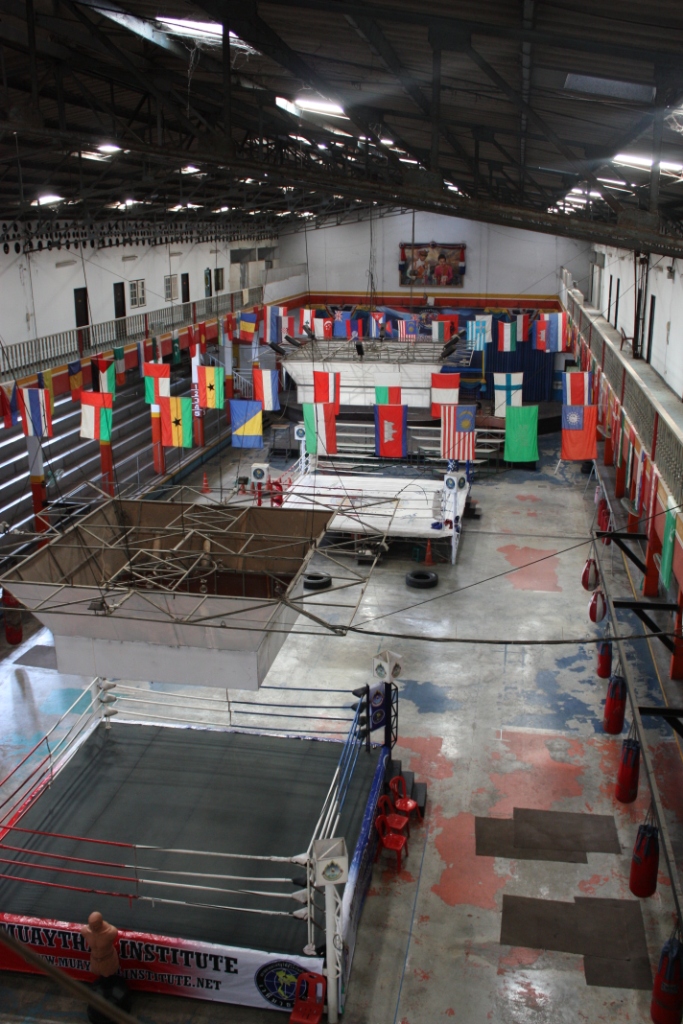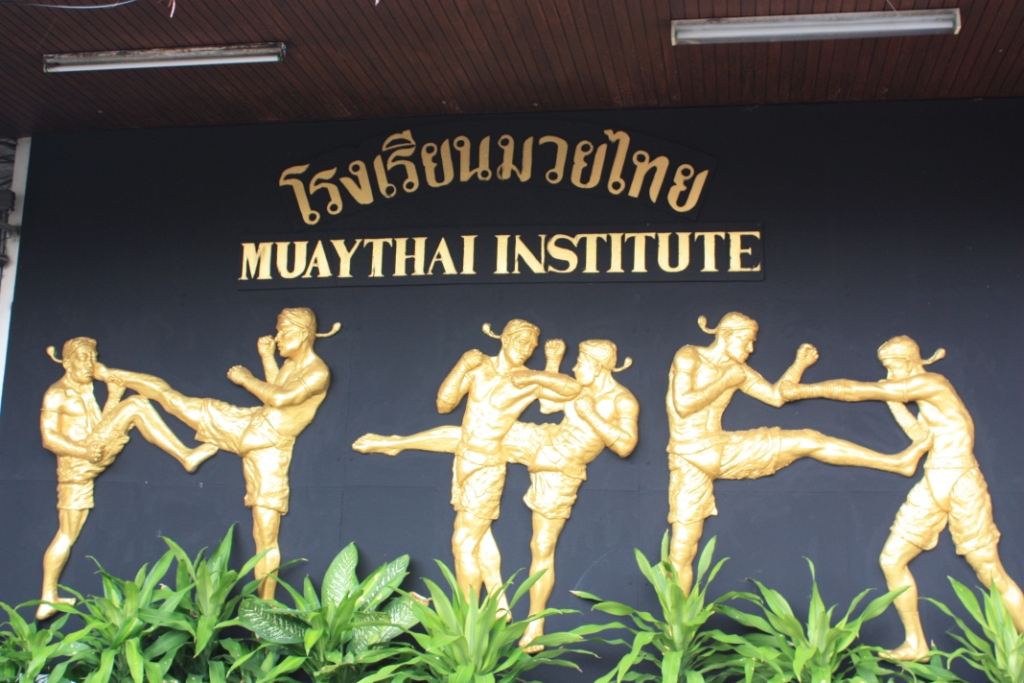
My Week at the Muay
Thai Institute
Bernie Gourley
The
Gi Yu Atlanta Dojo
03/18/13

Bas-relief
on the MTI façade
Why I Went
I was in Cambodia and Thailand last
October. During that time, I spent six days training at the Muay Thai Institute
(MTI) in Rangsit, Thailand. Sandhu-sensei asked me to write about my
experience.
Let me begin by discussing why I did
this. I was motivated on several fronts. First, I enjoy learning about almost
everything (e.g. I also attended a one-day Thai cooking class.) Second, I’m writing
a novel that features a Muay Thai (MT) master in a supporting role, and so
there was a research component to the trip. Third, it seemed like a good idea
to learn more about this style, which is widely practiced and much-emulated by
brawlers, given that I study jissen
(real fighting) budō.
However, the dominant reason was
that I believe in regularly stepping outside of my comfort zone. I went in
order to collect an experience that would force me to view myself (and familiar
problems) in a new light. Not long ago I read a biography of Miyamoto Musashi, and
I began to see how what he did and didn’t value in life helped make him the
warrior he was. He could’ve made a buku of koku
(i.e. a big salary) as a retainer, but he opted to walk around the country in
what we would today consider abject poverty in order to challenge himself. Don’t
mistake me, I’m not extolling poverty as a virtue. What I’m saying is that if one
values being comfortable (whatever that may mean, individually) over seeking
challenges, one’s growth will always be limited.
I think the greatest gift I’ve
received from my training is the ability to adopt this life philosophy. I’m a
shy and timid person by nature. However, everything we do in the dōjō trains us to live boldly. I’m not
just talking about actions like stepping out of the way of a bokken as it races towards one’s head.
That’s only the most obvious type of example. Learning to ki-ai with spirit, learning to say “onegaishimasu” loud and clear and like I meant it (rather than
mumbling it in fear that I’d mispronounce it or my tongue would trip over the
words—as has happens to me periodically), these actions, too, have played a
role in making me confident enough to face down my inner demons.
Before I move on, it’s worth
stating a few words about what I was NOT after. First, I wasn’t shopping around
for another martial art to devote myself to. When and if I’m back in Thailand,
I would train at MTI again in a heartbeat, but I have no intention of dividing my
precious and limited resource of training time into yet smaller slices. I knew
going in that MT would not be my ideal martial art for reasons that I’ll discus
later. Second, I didn’t pursue this training because I thought I had some big
gap for which I was hoping to cobble together a fix. If anything, I’ve always
worried about my personal inability to do justice to the huge amount of
material that we already have within the schools we study. While I make sure I
do some sort of training every day, whether I’m in the dōjō or not, I’ve never felt that I had such a command of the
schools we study that it was time to collect yet more techniques. In short, I
don’t want to be the type to collect a dozen different black belts, but have every
movement that comes out of my body be muddled, homogenized, and unpracticed.
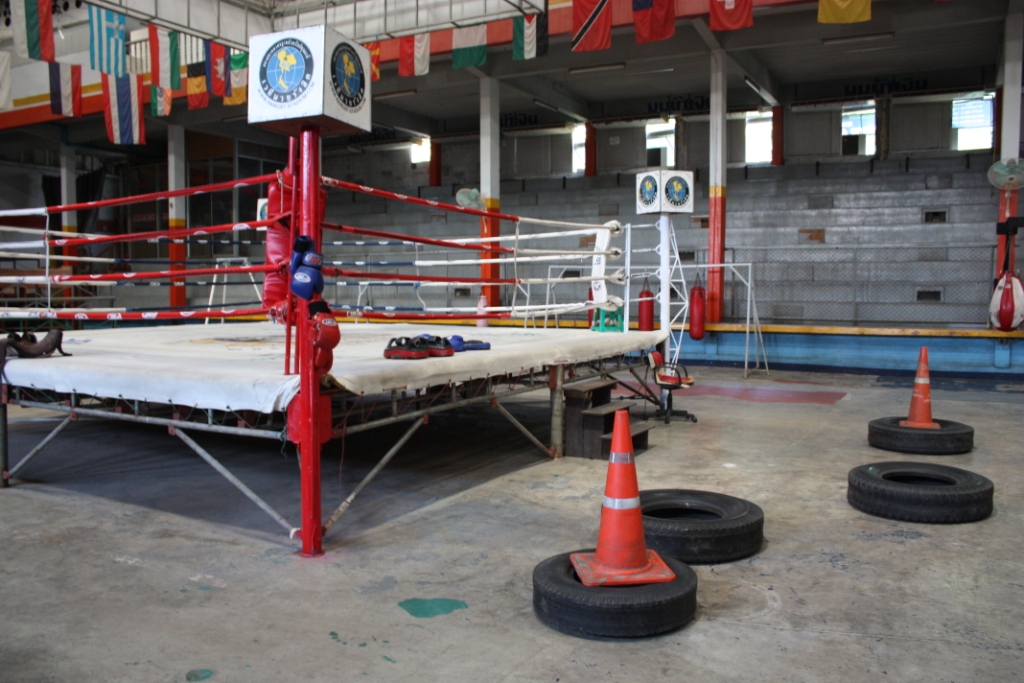
We bounced on those
tires to develop footwork rhythm and to tighten our calves.
The training
I trained 4
hours every day while I was at MTI. This was the typical (and recommended) schedule
for visiting students. The Institute ran four 2-hour sessions per day, and they
were open seven days a week. However, it was recommend that one train only six
days a week, at most, and most people did five or six day training weeks. A few
trained three sessions per day (i.e. 6 hours/day.) The Thai kids generally
trained only one session per day after school. I trained during the 7 to 9am
and 3 to 5pm classes.
The
training always began with a warm-up. The warm-up began with about a fifteen
minute run that was immediately followed by bouncing footwork drills on truck
tires laid flat on the floor. We would then do a stretch designed to loosen the
hip so that it could roll over for the MT style roundhouse kicks. This involved
standing on the floor and putting one foot up on the ring (between 3 and 4 foot
high) with the toes pointed up. One then rolled one’s leg inward so that the
inner edge of one’s foot touched the ring platform. As one did that, one pivoted
on the ball of the support foot as one would when kicking. Simultaneously, one
moved one’s hands into guard positions for this kick (i.e. the [initial] lead
hand comes back to one’s ear as the other hand sweeps down outside one’s
kicking leg.) We did 30 of these stretches per leg. Sometimes we would then
practice alternating knee strikes, bringing one’s knee up to about chest level.
After that, we’d get our first two-minute water break.
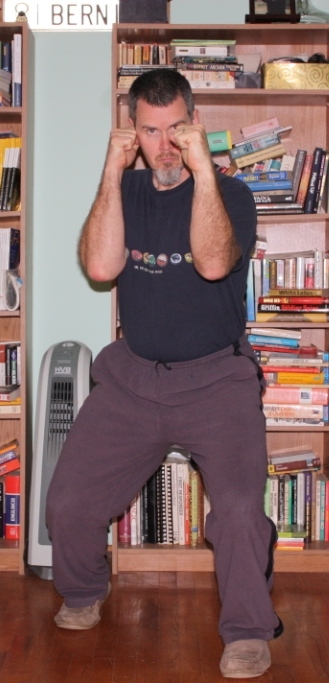
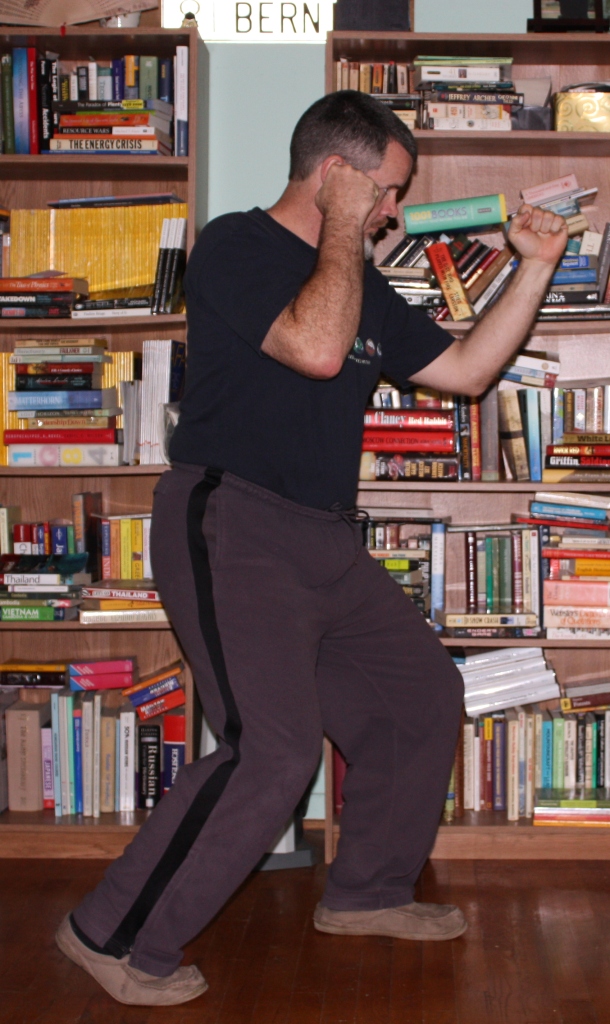
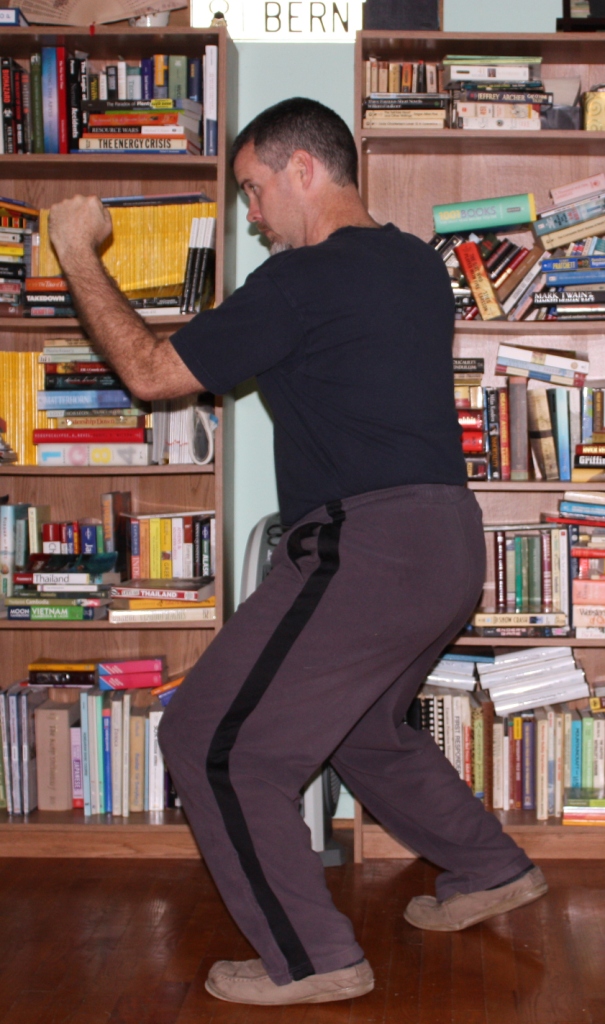
The basic MT guard
posture in forward, right side, and left side views
After warm-ups, the next thing that
level-one and -two students did was footwork drills. For a beginning level-one
student, one started by just holding one’s guard as one practicing stepping and
maintaining the proper interval between feet. We did several basic types of
footwork, forward-back maintaining a lead side, forward-back alternating (i.e.
lunge footwork), side to side, and circling around an opponent. On successive
runs of the drill, one would begin
delivering one strike (or defense) as one stepped, and then
one would build into progressively more complex combinations of strikes. The
weapons were fist, elbow, knee, shin, and foot. There were jabs, crosses,
hooks, uppercuts, roundhouse kicks, lead knee strikes, rear knee strikes, and
push kicks (lead and rear.) One worked through these various permutations using
the three footwork types.
There were also defenses to
practice. These included: lead-hand high-level deflections, lead-hand low-level
deflections, rear-hand high-level defections, rear-hand low-level deflections,
and a guard against roundhouse kicks that involved extending one’s lead hand
like metsubishi while lifting one’s
rear knee to one’s elbow such that the opponent’s kick would land on one’s shin
or forearm and not one’s ribs or neck.
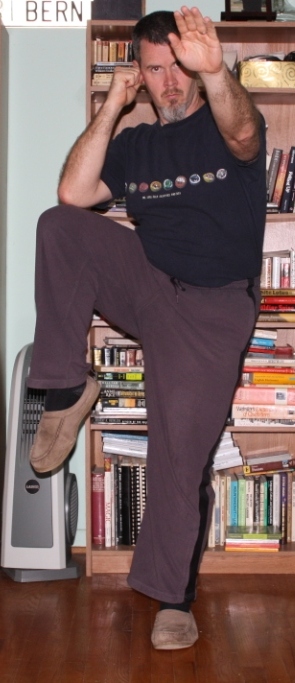
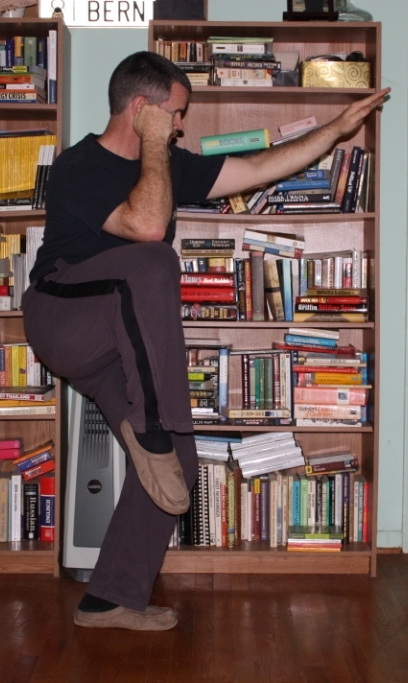
Defending the
roundhouse kick
Sometimes the instructors would put
steel rods that were about hand-width into our hands as we practiced these punching
drills. On occasion a chair or a cone would be used as a range reference and we
would practice circumnavigating that reference point while delivering strikes.
Alternatively, one might practice advancing into range while striking and then
back out while striking.
After
footwork drills, beginning students usually put on hand wraps and gloves and drilled
on the heavy bag. Often this began with two students facing across from each
other to either side of the bag with one student holding the bag; we’d then
alternate kicking the bag with a roundhouse kick on one side. We’d do 50 per
leg, and then rotate until each member of the trio had kicked with each leg.
After that, the drills were a similar series of combinations to those we
practiced in the footwork drills, but done while delivering the strikes to the
bag rather than in air. This allowed one to work on power, but with less
freedom of movement.
Because I
was there only a short time and was not in a certification track, they
reclassified me as a “freestyle” student about half way through the week so
that I would have a broader experience. From that point on, focus-mitt drills
and shadowboxing became a part of the training. Focus-mitt drills involved the
instructor extending out one of the MT pads at some orientation, and one would
deliver the appropriate strike depending upon its position and orientation. I
found this type of drill, which I haven’t done much of, to be extremely
beneficial. One has to recognize a target and act quickly upon it.
I must admit that I never really
understood the value of shadowboxing before my visit to MTI. I thought of it as
a sort of solo training that one does when one doesn’t have a training partner
at the moment—better than nothing, but just a make-do exercise. However, I
learned that there’s a lot of strategy involved in moving around the confines
of a ring, and Thaiboxers use shadowboxing to engrain in themselves good
strategy so that they don’t have to consciously think about it under the
pressure of the fight.
I also did “sparring” on one occasion; though
it wasn’t the free-form sparring that one would think of, but much slower and
geared primarily toward teaching.

Besides the support
leg heal being up, this may look familiarish.
Myths and
Misperceptions
There’s an old story that has been
told in both the Taoist and Zen Buddhist traditions. I’m sure most of you have
heard it. It’s about a cocky young student who goes to learn from a master, but
the student adopts the attitude that the master “won’t have to teach him much,
because he’s already got a solid foundation.” The master pours some tea for the
student, and soon the tea is overflowing the cup and scalds the student’s lap.
The master tells the young man that he cannot learn unless he first empties his
cup. Cognizant of this, I tried to go in with minimal preconceptions. Still,
one always carries some mental baggage with one, and what’s important is one’s willingness
to jettison preconceptions that prove wrong.
A few of my expectations proved wrong.
First, it seems to be widely
believed that MT practitioners aren’t diligent about mechanics. In other words,
critics say that MT fighters are fundamentally brawlers and don’t trouble
themselves with the minutiae of proper technical detail. MT is widely practiced,
and some of these critics may be speaking from perfectly correct--albeit
anecdotal--experience. My experience was different. The instructors at MTI were
meticulous about the details. If I was in guard and my elbow drifted an inch
from my ribs, I heard about it (i.e. and sometimes felt it.) If my feet were slightly
too wide or too narrow, I heard about it.
At MTI they’re struggling with the
fact that the MT genie is out of the bottle, but they would like to standardize
a curriculum globally so that the art doesn’t degrade into a muddle (part of
this is reflective of a desire to see Muay Thai in the Olympics.) The
instructors can’t really succeed at this point in standardizing a curriculum
that will apply to a MT gym in a strip mall in Chicago or a basement dōjō in Prague, but they do what they
can. And all they can do is to make sure that students running through their school
have a set of basics drilled into them.
Second, I
expected MT fighters to have zero grappling skill. It’s true that Thaiboxers generally
don’t have much grappling game. Practitioners consider MT to be a system of
self-defense and the descendent of a combat art, as well as being a sport.
However, in reality their style is shaped by the rules of their sport more than
by the dictates of real world attackers. The rules of the sport allow and
encourage takedowns, but once a fighter is on the ground the match resets. There’s
one area of grappling in which at least a few Thaiboxers are quite skilled, and
that is doing take-downs using techniques that are similar to our ko uchi gari and ko soto gari. To be honest, in the twenty-some fights that I
watched while I was in Thailand, most fighters seemed to ignore this skill in
favor of exchanging knee strikes when they’d get into a clinch. Maybe they
found it to be a low-success / risky maneuver. However, a few were very
effective with takedowns.
Third, I
expected some of the training might be brutal on the body, and that toughening
weapons might be part of the drill. MT is legendary for steel-shinned fighters.
If you don’t know what I’m talking about, YouTube search, “Crazy Man Kicks Down
a Banana Tree.” At MTI, however, there
was as much focus on safety as anywhere I’ve trained. In sparring, shin guards
were often worn, and we didn’t kick anything harder than a heavy-bag with our
bare shins.
Fourth, I
thought there would be no practitioners who were my age. It’s true that there
are few competitive fighters who are even in their 30s, let alone their 40s,
but there are some people who continue to train into their golden years. The
oldest instructor was about 70. As an aside, Master Ravee (the septuagenarian)
was a fascinating man. He had a 220 fight career. He won almost 80% of his
fights and held the Middleweight title for a while. (Note: That might not sound
impressive by today’s standards, but Thaiboxers have been known to do as many
fights in a week as a typical MMA fighter does in a year [e.g. 4].) Master
Ravee was legendary for his use of elbows. I’ve forgotten what his knockout and
TKO rate was, but it was staggering (i.e. something like 2/3 or ¾ of the fights
he won.) I think, but am not absolutely sure, that they fought mostly in rope
hand-wraps back in his day. Such ropes helped keep the little bones in one’s
hand from breaking, but didn’t really improve the civility over bare-knuckle
boxing.
One
preconception that was confirmed was that MT practitioners are, on the whole, extremely
fit. The instructors generally taught all four classes a day. My primary
instructor, Master Dang (a 400 fight career and the same age as me), ran the warm-up
with us each session, and then I’d see him in the evening or morning as he did
his “serious” run. My room overlooked the gym, so I’d occasionally see instructors
or fighters working the bag after hours. In short, they were machines.
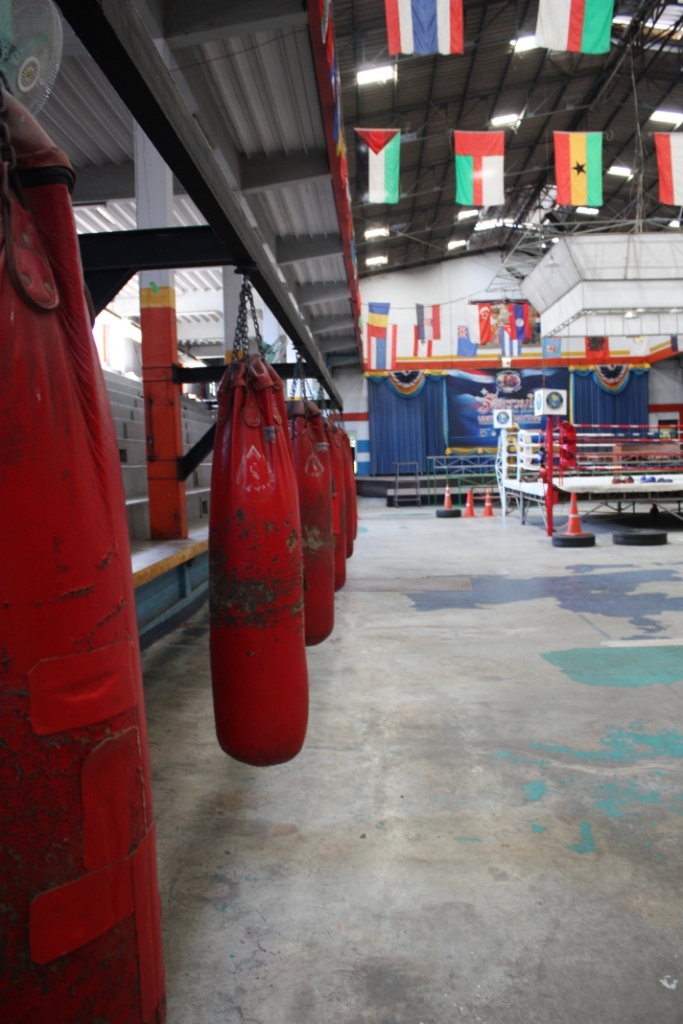
My Perceptions of Muay
Thai
Now we get
down to brass tacks. What did I think of MT as a martial art? I think that,
within their domain, Thaiboxers are a force to be reckoned with. Most of them
are highly skilled, strong, and tough as nails. Within their domain, I think
they can hold their own among those of any martial art. Why don’t I take up
Thaiboxing then? Because the domain in which they are extremely skilled is dangerously
small for someone interested in jissen.
Let me explain what I mean by
“domain.” If one could imagine all the possible combative situations one might face
and the varying skills one would need to deal with those situations, there is a
universe of combat skills. Different martial arts take on different sets within
that universe and explicitly practice to survive certain types of combat
encounters. Our art has a huge domain. We have specific techniques for: rear attacks,
multiple attackers, fighting on the ground, fighting standing, and even for fighting
submerged under water. We fight with spears and unarmed against people who have
spears. We use firearms, and practice disarming those who employ firearms against
us. We even have the odd technique for taking out a sentry.
A Thaiboxer’s domain is a single
unarmed attacker who, granted, uses many body parts as weapons. However, their
domain also subtracts out many attacks prohibited by the rules (e.g.
intentionally striking the crotch, intentionally striking the neck, choking the
opponent, etc.) It’s true that there is
carry over from the set of skills one explicitly practices to situations more
broadly. For example, fighting against a dog is not in the domain of skills
that I practice, but I suspect my chances are at least marginally better than
someone who spends their evenings sitting on the couch with a bag of Lays. (However,
not so good as someone who practices those skills specifically.) One does what
one trains, and if one’s domain is very limited one better hope one’s
opposition sticks to conventional attacks.
I will readily admit that there is
a cost to having a vast domain. One has to spread one’s limited time resources
more thinly over a broader base of skills. However, I think if one’s interest
is in jissen, one has to be ready for
quite a range of threats.
Another difference between what
Thaiboxers do and what we do is in the mode of mindset and strategic approach.
I think of this in terms of having a coup
de grace mindset versus having an endurance mindset. Professional bouts
consist of five three-minute rounds. Youths often do three three-minute rounds,
and one sees some variations. As you probably know from randori keiko (free sparring) going that long constantly exchanging
blows with only short breaks is very tiring. Therefore, the MT approach to
movement and striking is as much designed to keep one on one’s feet as to
deliver damage. In jissen, one has to
cultivate the ability to strike powerfully and end fights definitively and
quickly. That doesn’t mean that one always goes this route, but conditions may
require it. The opponent may have backup on their way. In combat with lethal weapons, the more
opportunities the opponent gets, the more likely it is that you end up in a body
bag. So there are a number of reasons that we train to be able to end the fight
decisively, even if that incurs a risk.
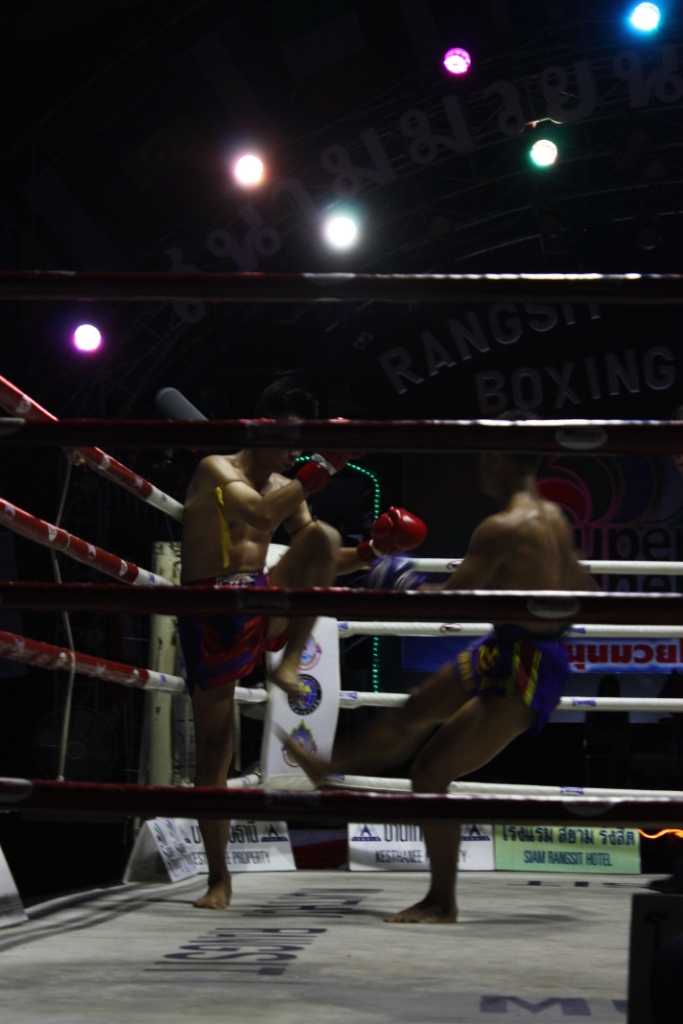
What our arts have in
common
Having
discussed some differences between our martial art and MT above, it’s worth noting
some similarities. In terms of mechanics, there are a number of similarities--the
human body is, after all, the human body. Their knee or elbow strikes aren’t
substantially different from the way we do them. However, I’d like to focus on
something other than the physical similarities.
I noticed a confidence and clarity
of action among the instructors and many students that wasn’t different from
any other diligent martial artists.

Wai Khru in progress
While their
rituals may look strange and incomprehensible, I think there’s a lot more
commonality in mental approach than one might expect at first blush. The Wai Khru is a great example of this. If
you’ve seen MT bouts, you’ll recall that at the beginning of each fight they
play a shrill flute and drum music and there’s a ritual that usually includes a
dance that each fighter carries out. If you haven’t seen a MT match (or you’ve
only seen one in the US—I don’t know that they routinely do Wai Khru here), you can YouTube search “Wai Kru” or “Wai Khru” and it will return numerous examples. The Wai Khru may appear strange and exotic,
but its two most important roles are: a.) to show respect to one’s teacher and the
relevant spirits/deities, and b.) to get the fighter’s head in the game. That
should sound familiar.
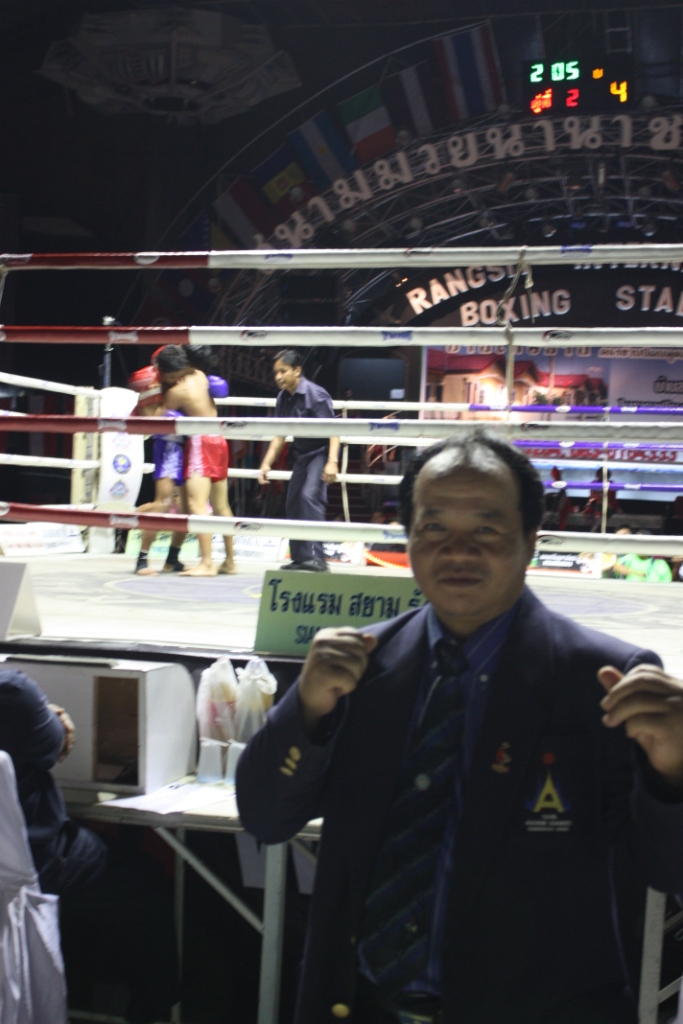
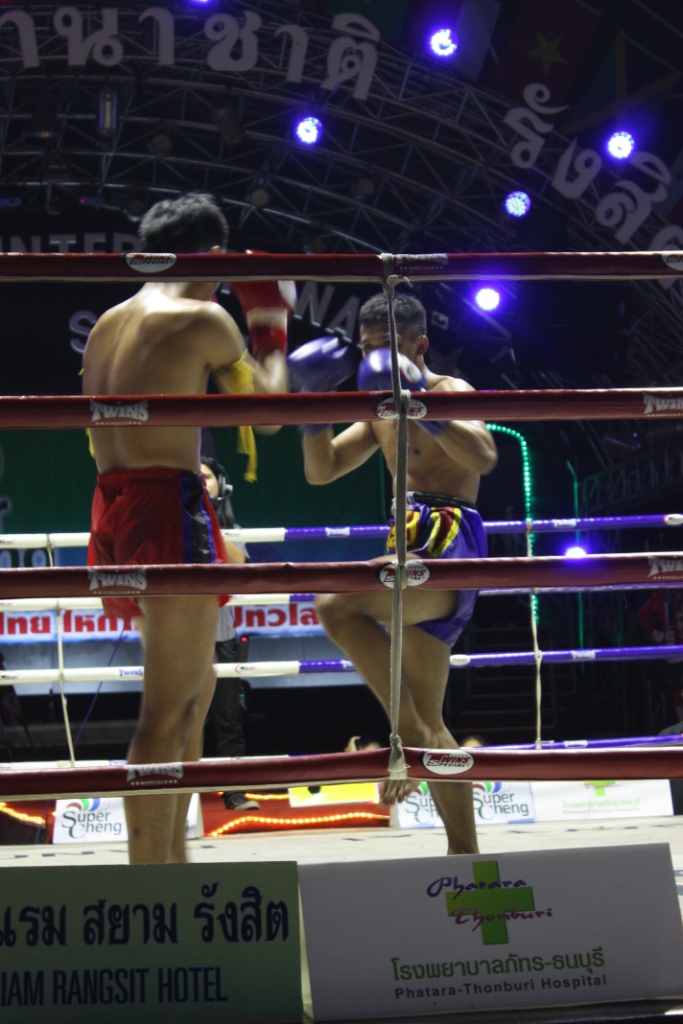
In the left hand shot
is Master Noi, one of the MTI instructors
What I learned that
will help me as a student of jissen budō
Three
things about my movement became apparent to me in Thailand. First, I sometimes
get sloppy with my guard. I’m not talking about letting it drop entirely. I
mean making it too slack or lackadaisical, or letting it drift. Second, I
learned that I tend not to deliver strikes while I’m retreating. I noticed a
proclivity in myself to associate advancing and attacking and retreating and
defending. In MT they emphasize that one should be striking when one is moving
back and away as well as when one is dominating. Third, I learned that I need
to optimize my footwork to the type of opposition I’m presently facing. One of
the errors that I was most frequently corrected for was getting too much of a
gap between my front and rear foot. Because we do a lot of movement at a range
disadvantage (i.e. mutō dori) or with
weapons, we tend to take bigger steps than do MT practitioners (also because we
bend our knees more deeply, which puts the feet further apart.) While I think
larger steps are appropriate for our movement, I can see the value of
conscientiously controlling that gap so as to minimize periods of weakened
balance—particularly in a one-on-one fist fight at the close ranges at which MT
fighters engage.
Closing notes
So
I guess my bottom line summary would be: If you have to fight a MT fighter in a
real world situation, don’t fight him in his domain. Throw a chair at him. Use
grappling. Get a weapon. Take it to the ground. But don’t go toe-to-toe in a knee
/ elbow range fist fight. That’s a sucker’s game.
I haven’t gotten into any of the logistical details of visiting MTI.
However, if you are considering going, feel free to contact me. I’d be happy to
provide information about things like what you should take, where to eat, how
to get there, etc. My contact info is: berniegourley@gmail.com
/ www.berniegourley.com
